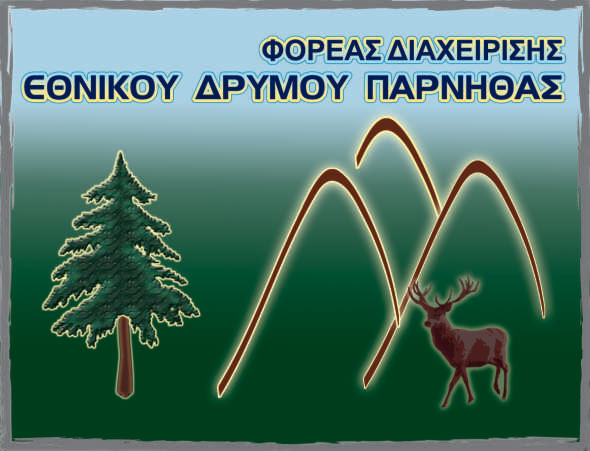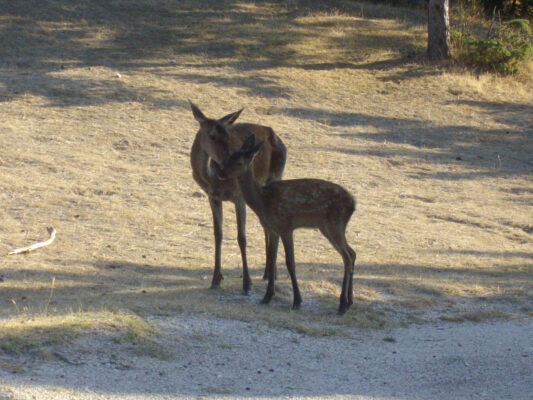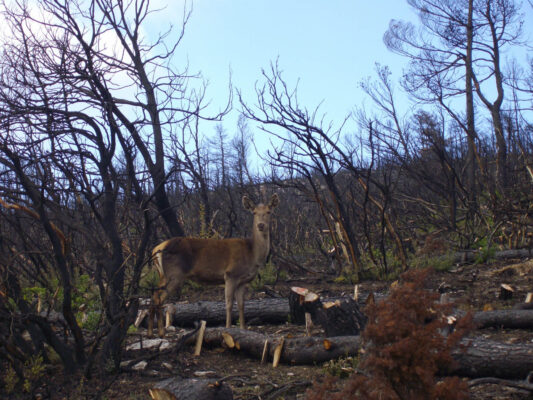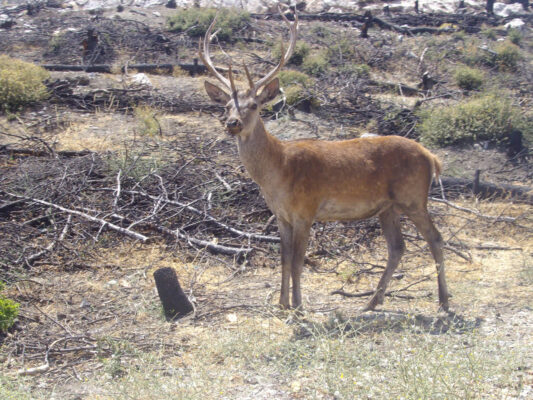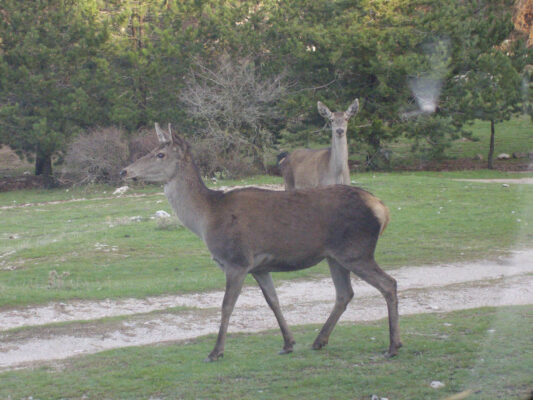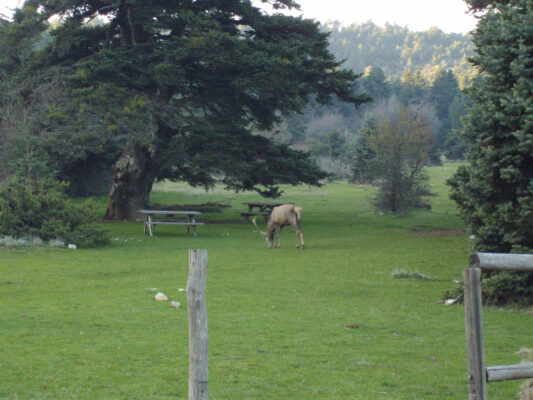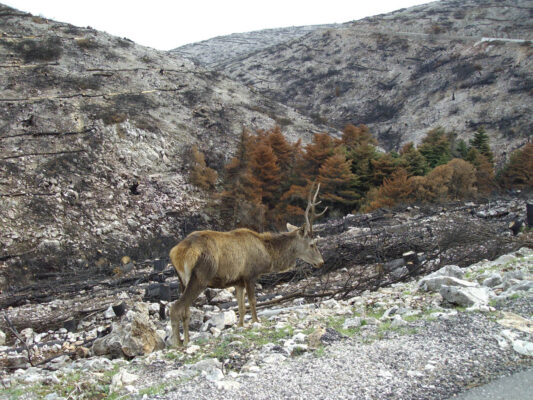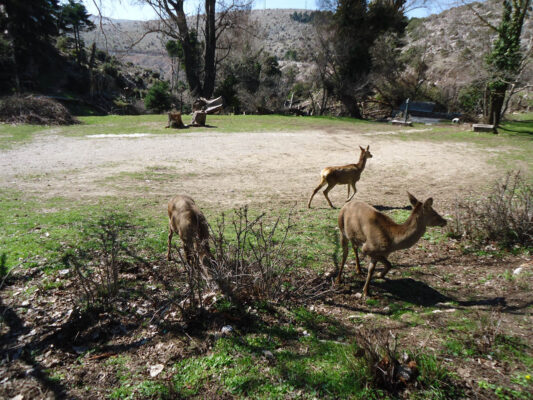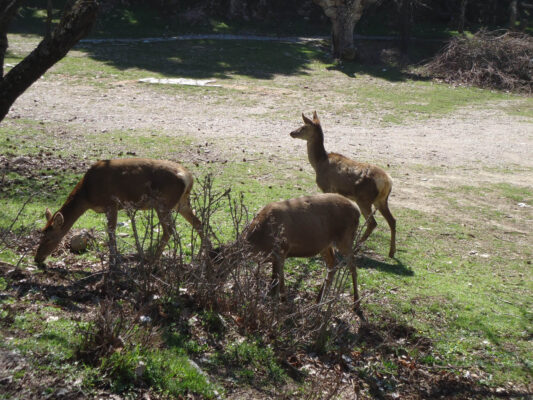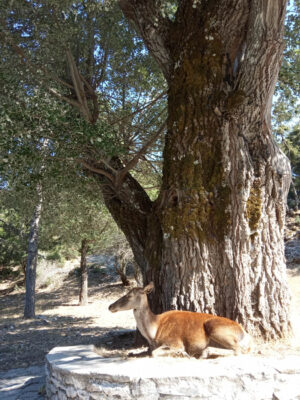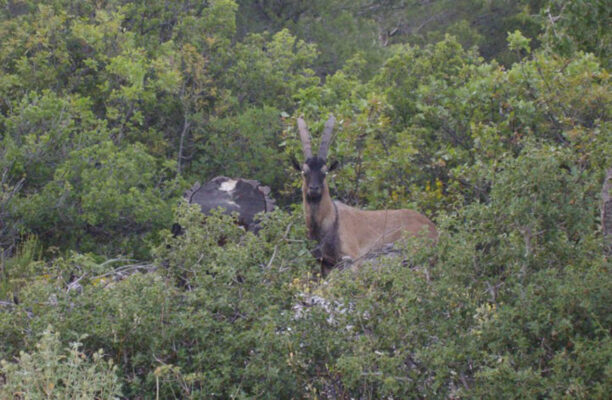FAUNA
Parnitha with its significant area, its rich flora, its varied terrain and the high protection it enjoys as a National Park, Game Sanctuary, Special Protection Area for birds (SPA) and area of the Natura 2000 Network, offers very good conditions for wildlife development. Thus, the fauna of Parnitha remains among the richest in Attica and despite adversity and human interventions maintains the largest number of red deer (Cervus elaphus) in Greece.
According to the Hellenic Ornithological Society (E.O.E.) and Assistant Professor A. Legaki (Department of Biology, EKPA), there are 158 species of birds in Parnitha, of which 28 are included in Directive 79 / 409 Annex I, 102 species are included in the Berne Convention Annex II, 58 species in the Bonn Convention and 18 species in the Greek Red Book. There are also 39 species of mammals, 25 of which are included in the Red Book and 32 in the Berne Convention. Finally, 29 species of reptiles and amphibians have been recorded, of which 24 species are included in the Berne Treaty and 4 species in Directive 92/43.
17 of the 39 mammals found in Parnitha are bats, which are included in the Treaty of Bern and in the Greek Red Book. The geomorphology of the area (holes, caves) offers shelter to bats. Also, old tree clusters, especially those found in wet areas, are favorable places for bat species that live in tree hollows. The population status of bats can and should be studied in Greece and especially in Parnitha where several endangered species are found.
The most representative mammal species found in Parnitha is the red deer (Cervus elaphus).
Red deer (Cervus elaphus)
The red deer is included in the “Endangered” species according to the Red Book, ie species that are in danger of extinction from their natural habitat in the near future, is protected under Directive 92/43 / EEC and is included in Annex III of the Berne Treaty
Parnitha maintains the most prosperous population in Greece that participates as a natural grazer in its ecosystem. It is the only natural population in the country, 75% of which is indigenous, ie descendants of deer that have always lived in Parnitha and is a separate isolated subpopulation.
The red deer belongs to the order Artiodactyla, and to the family Cervidae. Males weigh from 85-240 kg and females from 80-110 kg, with a life expectancy of 12-15 years and rarely 20-25 years.
It is one of the most beautiful mammals in our country. It has a long strong body, long neck, tall and strong legs that end in hooves. In summer its hair is reddish brown to reddish-brown, while in winter it becomes dark brown-gray. Newborns and young, 6-7 months old, have light reddish or reddish-brown hair and numerous cream-white spots on the sides of the body. Only males have horns, which are discarded every year.
It is a woodland species that prefers broad-leaved or mixed and sparse coniferous forests, with rich subsoil, several gaps and grasslands, which offer a variety of herbaceous and shrubby vegetation. It moves at different altitudes depending on the time of year and the weather conditions in the area. In summer we find it in the gaps of the fir forest, in flat meadows and plateaus of Parnitha, choosing cool places, mainly with NW exhibitions. It remains close to springs and streams, avoiding steep slopes, while the existence of broadleaf vegetation is an important criterion for its stay in the area. In winter it descends to low altitudes, where it finds refuge in the pine forests, in areas with little snow cover and sheltered from strong NW winds.
The deer does not easily change the environment in which it lives. However, in cases of overcrowding, severe disturbance (eg fire), lack of food and water or adverse weather conditions, it is forced to move to more favorable areas, sometimes crossing quite long distances. The migration of animals has a predetermined route and a specific destination and is always accompanied by a return trip to the original place of departure.
Seasonal deer migrations are aimed at the survival of individuals and are associated with the search for more favorable climatic conditions and the provision of food for a certain period of time, at the end of which the animals return to their place of origin. They take place twice a year, once in late spring and the other in late autumn. The main passages in the area of Parnitha are from Kiafa Platana to Klimenti and respectively, from Loimiko-Saloniki to Mola, from Tatoi Palace to Flampouri etc.
Migration during the breeding season is aimed at conserving the population and is related to ensuring more favorable conditions for reproduction and development of newborns. Movements are observed from the lowest to the highest areas. The most characteristic breeding points are Kiafa Platana, Roumani, Loimiko, Mola, as well as the ravines Mavrorema, Gouras, Kyriaki, Houni, Haradros. After the end of the breeding, the males move to quiet places with rich vegetation such as Skipiza, Kantalidi, Buffy etc.
It is pointed out that after the fire many deer populations moved to areas such as Tatoi, Dervenochoria, Avlona and generally to the unburned areas.
The red deer is a herbivore. Its food consists mainly of chestnuts, pseudo-plane tree, beech, willow, raspberry, ivy, wild pear, blackberry and various kinds of greaves and herbs. It also feeds on agricultural and livestock species such as vetch, peas, corn, beets, potatoes etc. In areas and during the seasons when the pots abound, the deer chooses them as the main food, while the shrubs and woody plants are of secondary importance. They also choose grasses when they are green and have a high leaf-stem ratio.
The deer is a social species and lives in herds, where perfect organization and hierarchy prevail. Males live separately from females, except during the breeding season. They form independent small groups of 4-6 people. Herds of females include their young, aged 1-3 years and usually consist of 12-20 people, where the leadership is taken by the older female. According to the conditions prevailing in Parnitha, the breeding season of the deer starts from the end of August and lasts until the middle of October. Suitable places for reproduction in the area of Parnitha are the places Viliani, Kiafa Platana, Loimiko, Mola, Goura, Limenti, Roumani. Suitable gaps for reproductive activities exist in Salonika, Bortiza, in the area of Platana etc.
Wolf (Canis lupus)
The reappearance of the wolf in Parnitha has been detected since 2012 in the National Park (initially by workers’ observations), while it had disappeared since the 60’s. The wolf is protected by Community legislation, with European Directive 92/43 / EEC, on habitat species and types, is a priority species (92/43 / Annex II, IV) and it is the country’s obligation to maintain its current population status. potential and the current spatial distribution in the area south of the 39th parallel.
12.06.2019 Scientific Meeting on: “Fauna Management and Monitoring in the Parnitha National Park”
The Management Body of Parnitha National Park organized a scientific meeting on Thursday, June 20, 2019 at 11:00 am in the conference room of the Institute of Mediterranean Forest Ecosystems (Terma Alkmanos, Ilisia – Athens) on “Management and Monitoring of Fauna in Parnitha National Park”. The material of the meeting is available to anyone interested below.
2. “Study on the bearing capacity of the Parnitha National Park” – University of Patras
3. “Reappearance of wolves in the Parnitha National Park” – “Kallisto” Environmental Organization
Cretan Goat (Capra aegagrus cretica)
There is a remarkable population of Cretan chamois (Capra aegagrus cretica), commonly known as Kri-kri, which was introduced to the forest in 1961, from Crete.
Deer (Capreolus capreolus)
In the area of Parnitha there is a small population of deer, but there is no population estimate or any study on this species.
The movements of deer to low altitude habitats had as a direct result the application of stronger pressures on the habitats and consequently on the deer populations (source Roumani, Agios Paraskevi, Voutima, Saloniki, A. Nikolaos etc.).
Hedgehog (Erinaceus concolor)
The species is characterized by the light color of the chest, in contrast to the darker rest of the abdomen. The length ranges from 225-275 mm. It is found mainly in Eastern Europe and is the only species of hedgehog that prevails in Crete and other Greek islands. It is found in forest areas, shrubs and grasslands, trees, gardens, parks, etc. It is a nocturnal species. Hibernation lasts from October to April. It feeds on insects, worms, snails.
Blind mole (Talpa caeca)
It is found in the Mediterranean area and only in the mainland. It is found in meadows and forest areas of broadleaf species. He spends his life almost permanently under the ground. It feeds on worms, insect larvae and other invertebrates.
Greater white-toothed shrew (Crocidura russula)
It is the most common type of shingles. Body length 65-85 mm. and tail length 35-50 mm. It is found in meadows, forest areas, tree lines and generally in dry soil. It feeds on insects, spiders, lice, snails.
Bicolored shrew (Crocidura leucodon)
Head and body length ranges from 65-85 mm while the hind legs do not exceed 13 mm. It is found in meadows, forest areas, tree lines and generally in dry soil.
lesser white-toothed shrew (Crocidura suaveolens)
It bears a strong resemblance to crocidura russula and uses the same habitat as well.
Etruscan shrew (Suncus etruscus)
It is the smallest shrew and one of the smallest mammals in the world with a head and body less than 45 mm. It is found in meadows, fields, gardens and is often found under stones and logs. There is limited information on this species.
European free-tailed bat (Tadarida taeniotis)
It is characterized by its large size and is one of the largest species in Europe. It is the only bat in Europe whose tail protrudes considerably from the membrane. It is found mainly in hilly areas or sea rocks but is also often found in cities.
greater horseshoe bat (Rhinolophus ferrumequinum)
It is the largest horseshoe bat (arm length 50-61 mm). It is found in wooded areas, caves, tunnels and cellars.
lesser horseshoe bat (Rhinolophus hipposideros)
It is the smallest horseshoe bat in Europe (arm length 35-42 mm). It is found in wooded areas, caves, tunnels and cellars.
Blasius’s horseshoe bat (Rhinilophus blasii)
Medium-sized horseshoe bat (arm length 44-50 mm). It is found mainly in caves.
Serotine bat (Eptesicus serotinus)
Arm length 48-55 mm. It is found mainly in forests but also around farms. It is also common in trees, buildings and occasionally in caves.
Common bent-wing bat(Miniopterus schreibersi)
Small bat with hair and head short and straight, and very large fins (arm length 42-48 mm). It is found mainly in the countryside, in caves and sometimes in buildings.
Lesser mouse-eared bat (Myotis blythi)
Slightly shorter than the Eptesicus serotinus with an arm length of 54-60 mm, it is found mainly in open, sparsely forested areas. They perch in caves and buildings all year round.
Geoffroy’s bat (Myotis emarginatus)
Small bat in shades of red and brown. The tip of the tail membrane with sparse hair (arm length 36-42 mm). It is found in caves and mines in winter, in trees and buildings in summer.
Greater mouse-eared bat (Myotis myotis)
Very large bat with arm length of 57-67 mm. It is found mainly in open sparse wooded areas. They perch in caves and buildings all year round.
Lesser noctule (Nyctalus leisleri)
It is a rare species and is found in wooded areas where they perch mainly in tree trunks and occasionally in buildings.
Common noctule (Nyctalus noctula)
Gold-brown hair with narrow wings and arm length of 46-55 mm is found in wooded areas and perches on trees.
Kuhl’s pipistrelle (Pipistrellus kuhli)
Lighter than other species of this family with a length of 32-35 mm, it is found in woodlands, farms, meadows, but usually near water. They perch on buildings and trees all seasons, sometimes in winter.
Nathusius’ pipistrelle (Pipistrellus nathusii)
This species has several similarities with the common bat of this family, except that its color is not uniform (arm length 32-35 mm). It is found mainly in wooded areas.
Common pipistrelle (Pipistrellus pipistrellus)
This is the most common species of this family, the color of which is uniform (arm length 28-34 mm). It is found in wooded areas, farms, pastures but usually near water. They perch on buildings and trees all season long, sometimes in caves in winter.
Savi’s pipistrelle (Pipistrellus savii)
It has an arm length of 32-38 mm and is found in wooded areas, farms, pastures but usually near water. They perch on buildings and trees all season long, sometimes in caves in winter.
Brown long-eared bat (Plecotus auritus)
This species is characterized by very large ears that make it stand out from other species of bats in Europe (arm length 34-41 mm). It is found in wooded areas. They perch on trees and buildings all year round, sometimes in caves in winter.
Parti-coloured bat (Vespertilio murinus)
This species is characterized by its wide and rounded ears (arm length 40-48 mm). It is found in wooded areas, farms, often in cities. In summer they perch on trees, buildings and crevices in rocks, in winter in deep caves and cellars.
Cape hare (Lepus capensis)
His hair is yellow-brown all year round, his legs long. His ears are also long and with black spots. This hare lives mainly in farmhouses and is also found in open wooded areas.
Forest dormouse (Dryomis nitedula)
Black tint around the eyes, short ears. Body and head 80-130 mm, tail 80-95 mm is found in forest areas, mainly broadleaf species, especially where there are dense shrubs.
Edible dormouse (Glis glis)
This is the largest species in the family. It does not have a black tint around the eyes, but black circles that emphasize their size (body 130-190 mm, tail 110-150 mm). They build nests high in tree canopies and feed on fruits and seeds.
Lesser mole-rat (Spalax leucodon)
It is a species slightly smaller than s.micropthalmus (body 26 cm, hind legs 20-25 mm, found in grass and cultivated soil.
Grey dwarf hamster (Cricetulus migratorius)
Species the size of mice without black spots (body 90-110 mm, tail 22-28 mm). It is found in grass and open forest areas.
Günther’s vole (Microtus guentheri)
White legs, tail long and light colored (body 100-120 mm, tail 20-30 mm). It is found in dry grass, meadows and crops where it can cause particular damage.
Pitymys (Pitimys savii)
It has several external similarities with the species pitymys subterraneus (body 85-105 mm, tail 25-35 mm, hind legs 14-16 mm).
Eastern broad-toothed field mouse (Apodemus mystacinus)
This species of mouse is the largest and most gray of any other in the apodemus family (body 100-130 mm, tail 105-140 mm). It is found in dry forest areas and on rocky areas covered by bushes.
Wood mouse (Apodenus sylvaticus)
It is the most common species of mice in most parts of Europe (body 80-110 mm, tail 70-115 mm). It is the predominant species of forest, but it is also found in gardens, hedges of shrubs and rocks. It is often found in houses and farmhouses.
Yellow-necked mouse (Apodemus flavicollis)
It has many similarities with the species apodemus sylvaticus (head and tail 90-120 mm). It is found mainly in forest areas but also in orchards and orchards. It is often found in coniferous forests and is limited to their narrow boundaries.
Black rat (Rattus rattus)
Hair color varies between black, brown and gray or brown and white (head and body 16-23 cm, tail 18-25 cm). Located in buildings such as warehouses, farms.
Brown rat (Rattus norvegicus)
Usually brown, sometimes its hair can be black. Tail thin and without hair on the head and body 20-26 cm, tail 17-23 cm). It is found in the areas where humans live (sewers, cellars). It is also found on shores, estuaries, etc.
House mouse (Mus domesticus)
It is a subdivision of the species Mus musculus and is the darkest mouse in Europe (head and body 75-95 mm, tail 70-95 mm). It lives mainly in or around houses, farmhouses, warehouses and factories but also in gardens, shrubs, rocks, etc.
Red fox (Vulpes vulpes)
Usually red-brown in color and in some cases black spots on the neck and bottom (head and body up to 75 cm, tail up to 45 cm). It is found in forests, meadows, mountains, farmhouses and more and more in cities.
Least weasel (Mustela nivalis)
It is the smallest sarcophagus. The size of the species varies. The tail is short and without a black spot (head and body 13-23 cm, tail 3-6 cm). It is found in all land habitats.
Beech marten (Martes foina)
White spot on the neck with varying size (head and body 40-48 cm, tail 22-26 cm). It is found in forest areas with deciduous trees and in rocky areas.
European badger (Meles meles)
It stands out from the black stripe that covers its white head (head and body 67-80 cm, tail 12-19 cm). It is found in deciduous forests, mainly trees and meadows.
All the recorded, so far, species of amphibians and reptiles that are found in the habitats of Parnitha, are found throughout Greece in various habitats and altitudes. With the exception of the Bufo viridis and Bufo bufo frogs that spend part of their lives in dry habitats, amphibians are normally found in wetlands and permanent waters. The various streams found in Parnitha are suitable habitats for amphibian species and the protection of aquatic fauna presupposes the protection of wetlands. Reptiles are associated with dry habitats and are not particularly endangered except by fires.
Parnitha includes a variety of habitats and is a safe haven for birdlife due to the declaration of the area as a National Park. Many species of birds, especially predators, which are protected by various treaties and are endangered, are found in the wider area.
European honey buzzard (Pernis apivorus)
Size 51-58 cm. This predator looks like a barb, but has a smaller head, a longer neck and a longer tail. The lower part of the wings has strong patterns. It is found in wooded habitats (pine, spruce). It is considered an immediately endangered species.
Short-toed snake eagle (Circaetus gallicus)
Size 63-69 cm. It has a large rounded head, with large yellow eyes resembling an owl. The lower part of the body and the wings are white. It has a short beak and short gray legs. It is observed during the breeding season in the area of Parnitha in wooded habitats. It has been designated as a strictly protected species by International Conventions (eg 79/409 / EU)
Northern goshawk (Accipiter gentilis)
Size 48-61 cm. It is the fastest and strongest of all the signs. Females are larger than males. The top is gray and the bottom is white with many horizontal black lines. It is found in woodland habitats throughout the year and is considered a vulnerable species.
Eurasian sparrowhawk (Accipiter nisus)
Size 28-38 cm. The female is smaller than the male. They have yellow eyes. The female has dark brown at the top and brown stripes at the bottom while the male has blond cheeks and a white spot on the neck. It is observed in shrublands, pastures as well as in wooded areas throughout the year.
Common buzzard (Buteo buteo)
Size 51-56 cm. It has a dark brown color on the top while the bottom is white with various designs. It has a short neck and wide wings. It is observed in Parnitha throughout the year in various habitats, eg wooded, shrubland, pasture, steep slopes. It is protected by the Berne Convention.
Long-legged buzzard (Buteo rufius)
Size 61-66 cm. It is larger than the Mouse Hawk, has a cinnamon tail without streaks and the lower part of the body is brownish red. Its flight resembles that of an eagle. It occurs in Parnitha during migration and is considered a strictly protected species.
Common kestrel (Falco tinnunculus)
Size 34 cm. The head and tail are gray. The upper part is maroon with black spots, the male while the female with dense dark lines. It is observed in Parnitha throughout the winter and is found in wooded areas, shrublands and pastures. Included in protected species.
Merlin (Falco columbarius)
Size 27-33 cm. It is the smallest predator in Europe. The female is larger than the male and has a dark brown top. The bottom is light ribbed. The male has a bluish-gray back and a strongly brownish-yellow underside. It is a migratory species and is found in Parnitha in winter. It is considered a strictly protected species.
Eurasian hobby (Falco subbuteo)
Size 30-36 cm. It is a fast bird and is characterized by sickle-shaped wings and a small tail. The upper part is dark gray and the lower part is dark spots. It is found in Parnitha during the summer months in wooded and bushy areas. Included in protected species.
Eleonora’s falcon (Falco eleonorae)
Size 38 cm. It is a dimorphic hawk. It is presented both as dark and as light. It is a migratory species and is found in wooded areas as well as in shrublands – pastures. It is included in the National Red List and is considered strictly protected.
Peregrine falcon (Falco peregrinus)
Size 38-48 cm. It is one of the fastest birds in the world. The female is larger than the male and darker in color. The plumage varies from dark to light gray at the top while at the bottom it has black streaks. It is a migratory species and is found in shrublands, pastures and barren slopes. Included in strictly protected species.
Rock partridge (Alectoris graeca)
Size 33 cm. It looks very much like the Island Partridge. The upper part of the body is gray-brown and has many thin streaks on the sides. It is found in shrublands, pastures and barren slopes throughout the year. Partridge hunting is controlled
Chukar partridge (Alectoris chukar)
Size 33 cm. It is very similar to the partridge. The upper part of the body is browner than gray and the ribs on the sides are wider and more intense. It has been reported that releases have been made in the Parnitha area.
Common quail (Coturnix coturnix)
Size 18-20 cm. The upper part of the body has white-yellow and black lines, the head is dark brown with a white line perpendicular to the center. It is found in shrublands, pastures and agricultural crops. Quail hunting is controlled.
Eurasian woodcock (Scolopax rusticola)
Size 34 cm. It looks like a snipe but it is bigger. During the day it lives in forests and bushy soils while at night it grazes in swamps and ravines. Snipe hunting is controlled.
Common black-headed gull (Larus ridibundus)
Size 35-38 cm. It looks like a blackhead and a seagull, because it has a red beak and legs. In summer the head is brown-chocolate and in winter it becomes white with black spots in front and behind the eye. It is found in residential areas and agricultural crops in the area of Parnitha.
Caspian gull (Larus cachinnans)
Size 56-66 cm. The most common gull in Greece. The male is larger in size than the female. The color of the upper part varies from dark gray to silver gray and the lower part is white. The legs and beak are yellow. It is found in residential areas and agricultural crops in the area of Parnitha.
Domestic pigeon (Columba livia)
Size 33 cm. The plumage is bluish-gray on the back with green highlights on the sides of the neck. It has a white urethra with two broad black stripes on the wings. It is found in barren areas and steep slopes throughout the year. Hunting is controlled.
Common wood pigeon (Columba palumbus)
Size 41 cm. It is the largest of the pigeons, it stands out with the wide white gallon on the wings and the white patch on the sides of the neck. It is found in wooded areas. Pheasant hunting is controlled.
European turtle dove (Streptopelia turtur)
Size 28 cm. From the smallest pigeons. Its body is brown with black spots in the middle of the wings. On the sides of the neck there is a white patch with small black lines. The chest is light pink and the tail is black. It is a migratory species and is found in wooded areas, shrublands and pastures. Hunting is controlled.
Eurasian collared dove (Streptopelia decaocto)
Size 31 cm. It is larger than a turtle, has a light brown color on the upper part of the body, a longer tail which is white on the back at the bottom. The head and bottom are light gray. It is found in residential areas. Hunting is controlled.
Common cuckoo (Cuculus canorus)
Size 33 cm. The upper part of the body is blue-gray and the lower part is white with dark streaks. The tail is long, gray with white spots. The females are dimorphic with other times the upper part being reddish brown and other times brownish-gray. It is found in shrublands, pastures and woodlands.
Barn owl (Tyto alba)
Size 34 cm. The only bird of the family found in Greece. He has long legs and a white heart-shaped face. The upper part is golden yellow brown, with many white and gray spots and the lower white. The eyes are black. It is found in wooded (pine) areas, shrublands and pastures throughout the year.
Eurasian eagle-owl (Bubo bubo)
Size 66-71 cm. The owl is the largest nocturnal predator in the world. It has big ears and big orange-yellow eyes. The plumage is brownish-red and has many lines and spots on the upper part of the body, while the lower part has sparse streaks and is lighter in color. It hunts birds up to the size of a pheasant and mammals up to the size of a hare. It is found in wooded areas.
Little owl (Athene noctua)
Size 22 cm. The upper part of the body is dark brown with many white spots and lines. The bottom is white with sparse brown streaks. Low forehead, big eyes and short tail. It flies at low altitude with ripples. It is found in wooded areas and shrublands.
Brown owl (Strix aluco)
Size 38 cm. The most common medium-sized night owl. He has no ears, a big head, a wide face and big eyes. Available in 2 phases, gray and brown. The upper part has black lines and spots and the lower part is light colored. It is found in shrublands, pastures and woodlands.
Long-eared owl (Asio otus)
Size 36 cm. Medium size bird with large ears, long face and body and orange-yellow eyes. The upper part is brownish-yellow or gray-brown with many lines and spots while the lower part is light colored. It is found in shrublands and forests.
European nightjar (Caprimulgus europaeus)
Size 27 cm. It is a nocturnal insectivorous bird with a long shape, gray-brown color, many dark streaks, small beak but wide mouth opening. Long, slender wings and tail. It is found in shrublands, pastures and woodlands.
Common swift (Apus apus)
Size 16.5 cm. It looks like a swallow but has a short tail, long wings and is black except for the larynx. Social bird and we often see it in cities.
European bee-eater (Merops apiaster)
Size 28 cm. Colorful bird with auburn head, brown-yellow top, light blue bottom, yellow larynx and green wings and tail. We see him in large flocks flying like a swallow. It is found in shrublands and pastures.
European roller (Coracias garrulus)
Size 31 cm. It has a large head, strong obscure black beak, plumage from light to dark blue with auburn-red back. It is found in wooded areas and agricultural areas.
Hoopoes (Upupa epops)
Size 28 cm. It has a reddish plume that has black edges and is sometimes open like a fan and sometimes closed. The head, neck and bottom are maroon. The beak is narrow and convex. It is found in shrublands.
White-backed woodpecker (Picoides leuconotos)
Size 25 cm. Stands out with the white or striped urinal. The male has a red top of the head and a neck. The bottom is white with black stripes on the sides. The wings have been shown solely to give a sense of proportion. It is found in wooded areas.
Eurasian wryneck (Jynx torquilla)
Size 16.5 cm. Looks like a woodpecker. It has a long tail, a long tongue that spreads it out to collect ants, a small head and a beak. It is found in shrublands and pastures.
Greater short-toed lark (Calandrella brachydactyla)
Size 14 cm. Brown top with dark intense streaks but white bottom. Crestless, with short, pointed, yellow beak. It is found in shrublands and pastures.
Crested lark (Calerida cistata)
Size 17 cm. The main feature is the always raised plume. The upper part of the body is gray-brown and the lower part is yellow-brown with lines on the chest. It has a relatively short tail that is dark. It is found in shrublands and agricultural crops.
Woodlark (Lullula arborea)
Size 15 cm. It has a small round plume, the tail has a white tip. It sits in the trees but grazes on the ground for many hours in small groups. It is found in agricultural crops.
Calandra lark (Melanocorypha calandra)
Size 19 cm from the largest lizards with a light yellow beak and 2 black patches on the right and left of the neck. The pale yellow breast has a few sparse brown streaks. It is found in agricultural crops.
Barn swallow (Hirundo rustica)
Size 19 cm. Its main feature is the long forked tail. The upper part is dark blue, the forehead and larynx are reddish brown and the rest of the chest and abdomen are white. It is found in shrublands and pastures.
Red-rumped swallow (Hirundo daurica)
Size 18 cm. It stands out with the red-yellow ureter and the brown-red neck. The head and back are blue. The lower part and the larynx are yellowish. The tail is forked but not very pointed. It is found in shrublands, pastures.
Common house martin (Delichon urbica)
Size 13 cm. And this swallow is found in cities and in the countryside. It is easily distinguished from the off-white bottom and the urethra, which give it a black and white appearance. The tail is short, forked and rounded.
Eurasian crag martin (Ptyonoprogne rupestris)
Size 14.5 cm. The lower part of the body is light brown with dark spots on the larynx. The abdomen and tail are dark brown. It is found in rocky areas.
Tree pipit (Anthus trivialis)
Size 15 cm. Soil-like bird but we often see it in the trees. It is very similar to Livadokelada. Main features are the upper part of the body brown with black streaks. Chest yellowish with spots. It is found in shrublands and pastures.
Meadow pipit (Anthus pratensis)
Size 14.5 cm. The differences with the tree tree are that the upper part of the body is more oily, the chest is white and with more spots. It is found in shrublands and pastures.
White wagtail (Motacila alba)
Size 18 cm. Black and white head, light gray back and urethra and white belly. The only black and white bird of this size with such a long tail. It is found in shrublands and pastures.
Grey wagtail (Motacila cinerea)
Size 18 cm. It resembles the white-tailed deer but has a longer black tail. The upper part is blue-gray and the lower part is yellow. It is found in shrublands and pastures.
Western yellow wagtail (Motacila flava feldegg)
Size 16.5 cm. With a slightly shorter tail than the previous ones with green-yellow at the top and yellow at the bottom. It is found in shrublands and pastures.
Red-backed shrike (Lanius collurio)
Size 17 cm. The only species in the family that has obvious differences between male and female. The male has a bluish-gray head and urethra, auburn-red back and a black band on the eyes that separates the thin white eyebrow from the off-white cheeks and neck. The tail is black with white outer wings. The bottom is white-pink. The female has faint reddish-brown colors at the top and light brown-yellow at the bottom. It is found in shrublands and pastures.
Lesser grey shrike (Lanius minor)
Size 20 cm. The bottom is light pink, has no white eyebrow and has relatively longer wings, shorter tail and short thick beak. It is found in shrublands and pastures.
Eurasian wren (Troglodytes troglodytes)
Size 9.5 cm. Tiny, round, brown bird with many streaks and light brown monochrome larynx. It has a small reddish tail, usually raised. It flies low and straight and pierces cotton wool and other shrubs.
Dunnock (Prunella modularis)
Size 14.5 cm. Dark gray head and lower body but with a dark brown crown and ear area. The top is also dark brown with black stripes. The sides are ribbed. The beak is black and thin. It is found in shrublands and pastures.
Common chiffchaff (Phylloscopus collybita)
Size 11 cm. It looks amazingly like the Prunella modularis. The differences are in his darker legs and voice. It is found in wooded areas.
Wood warbler (Phylloscopus sibilatrix)
Size 13 cm. The largest phylloscopus of the genus in the area. He stands out with his yellow-green upper body, the vivid yellow of his larynx and chest, his white belly, his yellow legs. It is found in wooded areas as well as in shrublands and pastures.
Common whitethroat (Sylvia communis)
Size 14 cm. The male has a gray head, white larynx and reddish wings while the female has a brown head and a pale pink color on the chest. The lower part of the body is light pink and the outer wings of the tail are white. It is found in bushy areas.
Garden warbler (Sylvia borin)
Size 14 cm. The upper part of the body is evenly brownish gray and the lower part is white. The head is round and the beak is relatively short. The legs are grayish with a blue tinge. It is found in wooded and bushy areas.
Western Orphean warbler (Sylvia hortensis)
Size 15 cm. The upper part of the body is dark gray. The head is black up to below the eyes and the neck. The larynx is white. The female has softer colors. It is found in wooded areas.
Eurasian blackcap (Sylvia atricapilla)
Size 14 cm. The male stands out from the woodpecker in that it has a black head, light gray lower body. Both (2) sexes have a dark gray top and a light gray larynx. The female’s head is reddish brown and the lower part is light brown.
Sardinian warbler (Sylvia melanocephala)
Size 13.5 cm. The male has a gray top, white bottom with a light gray side. The female is brown. It is found in shrublands and pastures throughout the year.
Rüppell’s warbler (Sylvia ruppelli)
Size 14 cm. The male has a black head and larynx as well as a white streak on the cheeks. The eyes are red. The upper part of the body is dark gray, the lower part is white and the tail is bright white on the outer wings. The female has lighter colors, white larynx and auburn legs. It is found in shrublands and pastures.
Western subalpine warbler (Sylvia cantillians)
Size 12 cm. The male has a bluish-gray upper body, the larynx and chest are orange-red. The female and juvenile birds have lighter colors with a light pink bottom. It is found in shrublands and pastures.
Goldcrest (Regulus regulus)
Size 9 cm. It differs from all Phylloscopus with the tiny beak, the black frame on the top of the head that is orange in the male and yellow in the female. The upper part is green olive, the lower part is pale white-yellow. It is found in wooded areas.
Spotted flycatcher (Muscicapa striata)
Size 14 cm. The upper part is gray with black spots on the head and light streaks on the white chest. The sexes are the same. It is found in wooded areas.
Red-breasted flycatcher (Ficedula parva)
Size 11.5 cm. The smallest flycatcher in the area. The upper part is brownish gray, the lower part is light yellow but the male’s chest and larynx are orange-red. The tail is black with bright white on the outer wings near its base. It is found in wooded areas.
European pied flycatcher (Ficedula hypoleuca)
Size 13 cm. During the breeding season the male is black on the upper part of the body and on the head. The bottom is white. It also has a small white spot on the forehead and a little white on the wings. Autumn looks like the female – brown oil at the top, white-yellow at the bottom, but retains the white spot on the forehead. The young look like females but have few spots. It is found in wooded areas.
European robin (Erithacus rubecula)
Size 14 cm. It has an orange-red chest and forehead, the upper part is uniformly brown and the tail is dark brown which is white below. The young without red colors have many brown spots. It is found in wooded areas.
Common nightingale (Luscinia megarhynchos)
Size 16.5 cm. Bird with an impressive song but without impressive features in appearance except for the brown-red tail. The upper part of the body is dark brown and the lower part is light brown. It is found in wooded areas.
Common rock thrush (Monticola saxatilis)
Size 19 cm. One of the most impressive mountain birds. In summer the male has a light blue head, neck and shoulders, white lower back, black wings and tile lower body. In winter the colors fade. The female and juveniles are speckled brown at the top and yellow-brown at the bottom. It is found in barren areas and slopes.
Blue rock thrush (Monticola solitarius)
Size 20 cm. The male stands out with its deep blue plumage and black feathers and tail. The female resembles the female Common rock thrush but is darker, brownish and without reddish color on the tail. It is found in barren and sloping slopes.
Black-eared wheatear (Oenanthe hispanica)
Size 14.5 cm. It has various color combinations. The male is a dimorphic bird, either with a black patch covering the eyes, cheeks, larynx or with a patch that does not cover the white larynx. The wings have been shown solely to give a sense of proportion. The back is light yellow-chestnut with a lighter head. The chest is also yellow-brown and the abdomen is white. The female has darker wings and cheeks than the male. It is found in shrublands and pastures.
Common redstart (Phoenicurus phoenicurus)
Size 14 cm. The red urinal and the homogeneous tail that moves trembling almost incessantly is one of its features. The male has a white forehead, black larynx and cheeks, gray back and orange-red chest and ribs. The female is gray-brown at the top and yellow-brown at the bottom. It is found in shrublands and pastures.
Whinchat (Saxicola rubetra)
Size 13 cm. It stands out with the intense eye strip and the white at the base and on the sides of the tail. The head and upper part of the male are brown with streaks. It has black wings with a white gallon. The larynx and chest are yellow-chestnut. The female has paler colors with a light yellow eye stripe and a smaller gallon on the wings. It is found in shrublands and pastures.
African stonechat (Saxicola torquata)
Size 13 cm. The male at the top is black with a small white patch on the urethra. The bottom is blond. The head and larynx are black with a little white on the right and left sides of the neck. The female and the minor are brown with black streaks, without white patch on the urethra and with a few spots on the neck. It is found in shrublands and pastures.
Common blackbird (Turdus merula)
Size 25.5 cm. The male is black with a yellow beak and a yellow eye ring. The female has a brown beak and fewer spots on the white larynx and chest. It is found in shrubs, pastures and agricultural crops.
Song thrush (Turdus philomelos)
Size 23 cm. The upper part is brown, yellowish with strong spots and smaller on the sides. The lower surface of the wings is also yellowish. It is found in wooded areas.
Redwing (Turdus iliacus)
Size 21 cm. It stands out with the brown-red sides as well as the white-yellow eyebrow. The top is darker than all brown chewing gum. It is found in wooded areas, shrublands and pastures.
Mistle thrush (Turdus viscivorus)
Size 27 cm. The largest of the chewing gums found in Greece. The upper part is grayish and the lower part is white with large and dense spots. The tail is gray-brown with white tips on the outer wings. It is found in wooded areas, shrublands and pastures.
Fieldfare (Turdus pilaris)
Size 25.5 cm. Smaller than hawk and larger than Song thrush. It has a bluish-gray head and urethra, brown back, has white reflections on the surface of the wings, black tail, larynx and deep yellow chest with strong streaks. It is found in shrublands and pastures.
Great tit (Parus major)
Size 14 cm. Black head, white cheeks, yellow lower part, greenish-gray upper part. It is found in wooded areas, shrublands and pastures.
Eurasian blue tit (Parus caeruleus)
Size 11.5 cm. It has striking blue and yellow colors. Head, wings and tail are light blue, bottom yellow, back greenish. It is found in wooded areas, shrublands and pastures.
Coal tit (Parus ater)
Size 11.5 cm. Its main feature is the white patch on the neck of the black head, the cheeks are white, the upper part of the body is grayish olive with double white gallon on the wings, the lower part is white with brownish-yellow sides. It is found in wooded areas.
Sombre tit (Parus lugubris)
Size 14 cm. The upper part of the body is brownish gray and the lower part is white with light brown color on the sides. Head and neck black to brown, cheeks white, and larynx black. It is found in shrublands.
Willow tit (Parus montanus)
Size 11.5 cm. Shows a special preference for swamps. It has a black head, white gallon on the wings and the sides of the white-gray bottom are deep brown-yellow.
Western rock nuthatch (Sitta neumayer)
Size 14 cm. The upper part is light gray but the lower part is dull white with light brown-yellow on the sides. It frequents and nests on rocks.
Eurasian nuthatch (Sitta europaea)
Size 14 cm. The upper part is bluish-gray and the lower part is orange, white cheeks and larynx. It is found in wooded areas.
Eurasian treecreeper (Certhia familiaris)
Size 12.5 cm. The upper part is brown with brownish-yellow streaks and the lower one is silver white. The beak is long, slender, convex. It is found in wooded areas.
Short-toed treecreeper (Certhia brachydactyla)
Size 12.5 cm. It is difficult to distinguish it from the Eurasian treecreeper, however its tail is less reddish, more brown, brown side, longer beak and more convex. It is found in wooded areas.
Corn bunting (Miliaria calandra)
Size 18 cm. The largest bird of the family Emberizidae. It has brownish-gray plumage and dark streaks all over the body. The beak and legs are yellowish. It is found in shrubs, pastures and agricultural crops.
Ortolan Bunting (Emberiza hortulana)
Size 16.5 cm. It has a brown belly, yellow larynx, gray-green head and chest, yellow eye ring and red beak. The upper part is brown with black stripes. The female has spots on the chest. It is found in shrublands, pastures, barren areas and steep slopes.
Cretzschmar’s bunting (Emberiza caesia)
Size 16 cm. It looks like a Vlach, but has a bluish-gray head and chest and a red larynx. The female has no yellow in the neck. It is found in barren areas and slopes.
Yellowhammer (Emberiza citrinella)
Size 16.5 cm. The male has yellow on the head as well as on the lower body, the back and the sides with dark brown streaks. Females and young males have more brown and less yellow colors but have a reddish brown tail. It is found in shrublands and pastures.
Cirl bunting (Emberiza cirlus)
Size 16.5 cm. The male has a dark oily green head, black larynx, yellow lines above and below the eye, the back and sides of the chest are brown and there are streaks on the sides. The characteristic of the female is the oil-green urinal. It is found in wooded areas, shrublands and pastures.
Black-headed bunting (Emberiza melanocephala)
Size 16.5 cm. Main features of the all-black head and the pure yellow lower part of the body. The head turns brown in autumn. The tail is brown and the ureter is lighter brown. The female has streaked oil-brown colors at the top and stands out with the yellow bottom. It is found in shrubs, pastures and agricultural crops.
Rock bunting (Emberiza cia)
Size 16 cm. The male is easily distinguished by the gray larynx and the gray head that has black lines. Also characteristic is the red-brown lower part of the body and the streaked brown urinal. The upper part is dark brown with black streaks. The female has a light brown color with streaks on the chest and sides. It is found in shrublands, pastures as well as in barren areas.
Common linnet (Carduelis cannabina)
Size 13.5 cm. During the breeding season the male has a red forehead and chest. It has brown shoulders and dark brown wings at all times of the year. The forked tail is dark brown with white lines on the tips of the wings. In winter the chest is light pink and the abdomen is brownish-yellow with dark brown streaks. The head is grayish and the beak is dark brown. The female and young individuals do not have red colors and are more brownish-gray and with more streaks. It is found in shrublands, pastures and agricultural crops.
European greenfinch (Carduelis chloris)
Size 14.5 cm. The largest bird of the Spizidon family. It stands out with the vivid yellow gallons on the wings as well as the yellow urinal and the yellow patches at the base of the tail. The thick beak is white. The female has lighter colors to gray with less yellow. It is found in shrublands, pastures and wooded areas.
European goldfinch (Carduelis carduelis)
Size 12 cm. Colorful bird with red face, black and white on the back and sides of the head, black, yellow, and white on the wings, light brown back ending in a white ureter and black and white tail. It is found in wooded areas as well as in shrublands and pastures.
Eurasian siskin (Carduelis spinus)
Size 12 cm. The male yellow-green with black crown and chin. The back and sides with dark streaks. Yellow are also the streaks on the wings, the sides of the tail. Females and juveniles are grayish with less yellow colors, not black on the head. It is found in wooded areas.
Hawfinch (Coccothraustes coccothraustes)
Size 18 cm. It has a very thick beak, metallic blue in summer, pale yellow in winter. The general color is brown with the bottom slightly pink. The wings have blue-black tips and a wide white gallon. The female has paler brown colors and the minors have dark streaks on the pale yellow sides and a yellow patch on the neck. It is found in wooded areas, shrublands and pastures.
Common chaffinch (Fringilla coelebs)
Size 15 cm. It stands out especially when it flies with the double vivid white gallon on the wings, the white on the outer wings of the tail and the also white patch on the shoulders. The male has a ruby lower part of the body, a bluish-gray head and neck, a green ureter and a brown back. In females and young, the upper part is dull green olive and the lower part is grayish. It is found in agricultural crops, shrublands, pastures and wooded areas.
Brambling (Fringilla montifrigilla)
Size 14.5 cm. Bird of the North that reaches Attica in autumn. It stands out with its elongated white urethra and orange-yellow chest and shoulders. The male has a black head and mantle during the breeding season that turn brown in winter like the female and juveniles. Yellowish nose and black wings with yellow streaks. It is found in wooded areas.
Red crossbill (Loxia curvirostra)
Size 16.5 cm. The most common of the crossbows of the genus loxia. Like the others it has a crossed beak to extract the seeds of coniferous trees. The plumage of the male is mainly red while the plumage of the female is green with yellow ureter and lower part. All have dark brown wings and a forked tail. It is found in wooded areas.
European serin (Serinus serinus)
Size 11.5 cm. Green-yellow striped bird with a stocky beak and a vivid yellow urinal. The male also has a vivid yellow forehead, larynx and chest. The female is dark gray with more streaks and no yellow on the urethra. It is found in wooded areas.
House sparrow (Passer domesticus)
Size 14.5 cm. We easily distinguish the male with the brown neck, the gray head and urethra, the black larynx and white cheeks. The female and young have light brown upper body and light gray lower. It is found in agricultural crops and residential areas.
Eurasian tree sparrow (Passer montanus)
Size 14 cm. The two sexes are similar to each other and the male sparrow but stand out with the brown head, the small patch on the white cheeks and the yellow-brown ureter. It is found in shrubs, pastures and agricultural crops.
Rock sparrow (Petronia petronia)
Size 14 cm. Lighter in color than other sparrows, short tail, light brown at the top with white streaks, white at the bottom with faint brown lines. There is a pale yellow patch on the upper part of the chest. It is found in rocky mountains and in ruins of buildings.
Common starling (Sturnus vulgaris)
Size 22 cm. The black bird that we see in large flocks, especially in winter, both in the countryside and in cities. The plumage has greenish and purple iridescences and dense whitish spots. The tail is short and the wings are pointed. The long pointed beak is black in winter, yellow in spring and summer.
Eurasian golden oriole (Oriolus oriolus)
Size 24 cm. The male is very different from the female, has striking yellow colors on most of the body and black wings and tail. The female is greenish-yellow with black wings and tail and white-gray bottom. It is found in shrublands and pastures.
Corvus Corax (Corvus corax)
Size 64 cm. The largest black bird in the area. It stands out not only in size but also in the thick, strong beak. It is found in wooded areas and shrublands.
Hooded crow (Corvus corone cornix)
Size 47 cm. The back and lower part of the body are gray. The rest of the plumage is black. The beak is thick and strong. It is found in agricultural crops, shrublands, pastures and wooded areas.
Western jackdaw (Corvus monedula)
Size 33 cm. From a distance it looks all black but the lower part of the body is dark gray, eyes light gray. It is the smallest of the crows, with a small beak. We often see it in the cities, in old castles, high rocks, ruined buildings, agricultural crops.
Eurasian jay (Garrulus glandarius)
Size 33 cm. The lower part of the body is light pink and the upper part is brownish pink. On the head it has black and white streaks that often rise and form a plume. On the wings it has an intense white gallon and blue and black spots on the covers. The tail is black and the urethra is white. The eyes are blue. It is found in wooded areas.
Eurasian magpie (Pica pica)
Size 46 cm. Black and white bird with a long tail that we often see in villages. The wings, abdomen and ribs are white. The rest of the plumage is black. It is found in agricultural crops, shrublands and pastures.
Lesser spotted eagle (Aquila pomarina)
It is a relatively small eagle with a size of 60 cm. Its color is brown while the young individuals have two rows of white spots on their wings. It nests in shrubs and feeds on small mammals, reptiles, frogs, insects, etc.
Golden eagle (Aquila chrysaetos)
It is a large and strong bird with a length of 1m. and wingspan of 2.5 m. Adults have golden hues on the back of the neck. Its color is dark brown. It usually flies very high making circles without flapping its wings.
Lanner falcon (Falco biarmicus)
Size 40cm. It is very similar to Falco peregrinus (it is lighter in color and has a narrower mustache). His back is auburn (in young people dark brown). The abdomen is grayish with brown streaks and has a yellowish cap on the head. It usually nests on rocks and less often in forests.
Black stork (Ciconia nigra)
It stands out from the white stork by the black glossy plumage and only the part of the abdomen is white. It is a cowardly lonely bird. It nests in deserted riparian forests. It migrates at the same time as the other storks.
White stork (Ciconia ciconia)
It is the most common stork in our country. Its size reaches 1 m. The plumage of its body is white and its wings black. Its beak is shiny, pointed and red. His legs are also red. It places its nest not only on trees but also on human plants. It is a very social species and feeds on fish, rodents, frogs, worms, snails, etc.
Griffon vulture (Gyps fulvus)
The main feature is the bare gray head of feathers. The beak is light in color, very strong and long. The rest of his body is 1m long. about and its plumage is gray-brown. It lives in rocky and steep areas. It feeds on dead animals.
Black kite (Milvus migrans)
It has a dark blond red color and a whitish streaked head. the wings are narrow. Its body size is about 55 cm. It feeds mainly on carcasses and dead fish, but also hunts smaller birds or small animals.
Egyptian vulture (Neophron percnopterus)
The smallest vulture in our country. Its length is 60-70 cm and the wingspan is 160-180 cm. Adults are white with black wings. In addition to carrion, it also eats insects, reptiles and small mammals. It nests in rocks and caves.
Western marsh harrier (Circus aeroginosus)
Size 48-56 cm. It is distinguished from other circuses by its larger size, wider wings and the absence of white in the urethra. The plumage varies. The adult male is distinguished from other circuses by its ribbed, yellowish head, neck and chest and vivid brown underside. Females and juveniles are dark brown with a creamy head and shoulders. He hunts, attacking from a low height on the reeds.
Bonelli’s eagle (Hieraetus fasciatus)
Size 66-74 cm. Strong and combative predator often hunts in pairs and prefers slopes with bushes or sparsely forested. It feeds on medium-sized mammals and birds.
Levant sparrowhawk (Αccipiter brevipes)
It exists mainly at low and high altitudes and prefers for nesting tall trees in small clusters near streams and on the slopes of valleys. It feeds on small birds, lizards, and large insects.
Lesser kestrel (Falco naumanni)
It nests in lowland areas, mainly at low altitudes. It feeds in warm, open areas with low vegetation. These areas include meadows, pseudo-steep areas, non-intensive agricultural crops and occasional toasts and open forests.
Vipera ammodytes (Vipera amnodytes)
It is a snake whose bite can become very dangerous to humans. Its average length is 60-80 cm. It is found in dry, sunburned locations with stony soil and not much vegetation. Adults feed mainly on small mammals and occasionally on birds, lizards and other snakes.
Four-lined snake (Elaphe quatorlineata)
Four-lined snake is one of the largest European snakes and can grow up to 250 cm in length. It is found in steppe, semi-arid sites, covered with bushes, or on the edges of open deciduous forests. It feeds mainly on rodents.
European ratsnake (Elaphe situla)
Its length reaches about 100 cm. It eats small rodents, lizards and young birds. It is found in dry, stony locations, in shaded valleys with streams and in ditches along roads.
Dahl’s whip snake (Coluber najadum)
It is a snake with a slender body that usually has a length of no more than 80 cm, although exceptionally it can reach 130 cm. It is found in rocky, sunny areas, at the foot of hills and mountains, with evergreen vegetation or tall grass.
European blind snake (Typhlops vermicularis)
He spends most of the day hiding under rocks or in deep underground galleries, which he digs alone. It is found in wet locations in mountains, on sandy beaches and in dry steppes. Their main food is ants.
Eyed skink (Chalcides ocellatus)
Length about 20 cm. Occurs in dry lowland locations with sandy or fertile – muddy soil. They feed mainly on insects and other invertebrates.
European copper skink (Ablepharus kitaibelii)
The European copper skink is an elegant small animal, less than 10 cm in length. It is found mainly in fallen leaves on the borders of warm oak forests and in forested steppes where fluffy oak and other deciduous trees grow.
Deaf adder (Anguis fragilis)
Although the Deaf adder is a lizard it can easily be confused with a snake because it is efficient. It is found in the surroundings of forests and bushes, in forested steppes, in cultivated areas, in gardens, on shores with large bushes.
Common wall lizard (Lacerta muralis)
It is a species of lizard with a length of 15-20 cm of which 60% is the tail. It is common in cities and forms small communities in old buildings and historical monuments. It is always frequented in places with a humid microclimate, preferring mainly the lowlands and only in some places it is found at an altitude of more than 1000 meters.
Balkan green lizard (Lacerta trilineata)
The Balkan green lizard is a large species with a length of over 50 cm. The tranosaur is found mainly in the lowlands, avoids the mountains and only occasionally is located at an altitude of over 1000 meters. It feeds on small vertebrates and insects and occasionally eats fruit that has fallen to the ground.
Marginated tortoise (Testudo marginata)
It is the largest land turtle. It is found on dry sunny hills covered with bushes but remains close to water. It is an almost exclusively herbivorous species and feeds mainly on soft leaves, shrub shoots, grass and fruits found in the soil.
Hermann’s tortoise (Testudo hermanni)
Length 25 cm. They are mainly herbivores. They feed on leaves, tender shoots, grass and fallen fruit, but when given the opportunity they also eat slow-moving invertebrates. It lives in dry places, in the lowlands and sometimes lives on the beaches.
Kotschy’s gecko (Cyrtodactylus kotschyi)
It is found on old stone walls of houses, in the street lights devouring every small insect and they have been observed climbing rocks in the late afternoon, in the sunlight.
Sheltopusik (Ophisaurus opodus)
This lizard looks like a snake in size and appearance but its eyelids, auditory slits and other features indicate that it is a lizard closely attached to the cognac. It is a long reptile that reaches up to 130 cm in length and the most probable place to be found is in sunny edges of vineyards, open forests or olive groves. Its diet varies and consists of slugs, snails, worms, small rodents and young birds.
Balkan wall lizard (Podarcis taurica)
It has no specific requirements regarding its accommodation and lives practically everywhere, in ditches along the roads, on bushy hills, pastures and rotten wood. The lizard’s habits, diet and management are similar to those of Lacerta agilis.
Balkan whip snake (Coluber gemonensis)
This snake is common in stony soils, vineyards, olive groves and generally in areas with green shrubby vegetation. It is a typical ground snake that does not like to climb trees and shrubs. Its average length is 100 cm -120 cm. The main prey of this snake is lizards but also young birds and small mammals.
European cat snake (Telescopus fallax)
It is found in hot, dry and stony areas. During the day it hides under large stones, in crevices or stone walls and hunts early in the morning or after dusk. It lives almost exclusively with small lizards.
Grass snake (Natrix natrix)
This snake is the most common of all European snakes and is found along rivers, swamps, small lakes and in farmland by lakes. It feeds on various amphibians and rarely on mammals found near water. It overwinters in rock crevices, in deep rodent nests, hollow trees and other similar shelters often at a great distance from the water.
Fire salamander (Salamandra salamandra)
The salamander, which reaches 20cm. length, is one of the largest and most beautifully colored amphibians in Europe. Being a nocturnal animal, it comes out of its hiding place during the day only after heavy rain. It feeds on snails, slugs, some beetles, myrrh and various species of worms. Adults are not limited to areas where there is water, but they need it to reproduce.
Smooth newt (Triturus vulgaris)
This species is one of the most common amphibian species in Europe. It is found on shores, along stagnant waters, or on the banks of rivers that flow slowly, in low altitude areas, in cultivated areas, but also in mountains up to 1500 m. It feeds on various invertebrates, aquatic or terrestrial depending on the season.
European tree frog (Hyla arborea)
It spreads to almost all of Europe, except in some parts of France and Spain. The length of the adults reaches 5 cm. It is mainly a nocturnal species and prefers areas with shrubs and trees. It is a climbing frog that rarely lands on the ground. It feeds on flying insects which it captures with great agility.
Agile frog (Rana dalmatica)
It is a small frog (up to 6.5 cm for adult males and up to 8 cm for females). Its color is light yellow with green streaks on the back and abdomen. It is a species of frog that lives in streams, in or around forests. Prefers stagnant water or slow-flowing water with vegetation (reeds, aquatic plants).
Marsh frog (Rana ridibunda)
It is the most common frog. It lives in all stagnant or slowly moving waters. It lives in water in areas with dense vegetation. Its color is yellow-green to green. It has very long hind limbs and can make big jumps.
European toad (Bufo bufo)
It is a frog that can live in dry environments. It only needs water to give birth. It lays its eggs in stagnant water or in low flowing water. It is a nocturnal animal. It feeds on insects, and other small arthropods or worms. It has poisonous glands on its skin.
European green toad (Bufo viridis)
It is smaller than the soil toad. Its color is green with white streaks. His feet are not very long and he can walk quite well on dry ground. Organically it looks like a soil toad.
Greek stream frog (Rana graeca)
It is a species that spreads in the Balkan Peninsula. It lives in stagnant or slowly moving waters. It is found in various types of altitudes from 240 m – 1400 m.
Red deer – Cervus elaphus (photography: Stergiopoulos Christos )
Cretan Wild Goat – Capra aegagrus cretica
